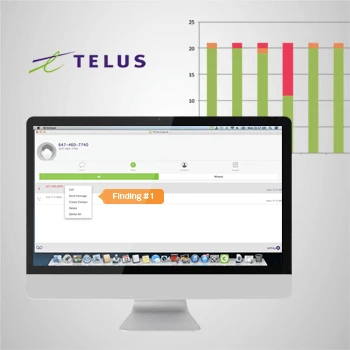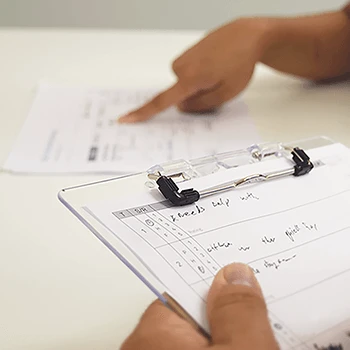What exactly is a UX testing sprint and how does it differ from traditional usability testing?
A UX testing sprint is an accelerated validation method that rapidly tests digital product designs with real users to identify usability issues and optimization opportunities within compressed timelines. Unlike traditional usability testing that often follows longer research cycles, testing sprints emphasize immediate actionability through focused objectives and streamlined analysis. Through our Experience Thinking framework, we integrate sprint testing across Brand, Content, Product, and Service touchpoints rather than isolating interface evaluation, creating connected insights that inform holistic experience improvements.
Tip: Define clear success metrics before starting so your sprint delivers actionable insights rather than general feedback.
How do UX testing sprints fit within your broader Design on Track framework?
UX testing sprints are integral to our Design on Track methodology, which includes Steps (1-2 days), Sprints (4-5 days), Runs (3-4 weeks), and Relays (12 weeks). Testing sprints specifically validate design decisions at critical development points, whether as standalone Test Sprints or integrated testing phases within Design Sprints and Runs. This flexible approach allows testing to scale with project complexity - from quick validation steps to extended testing runs that de-risk complex, high-impact design decisions. The framework ensures testing timing aligns with development needs rather than forcing rigid testing schedules.
Tip: Match testing sprint duration to your project scope and timeline constraints rather than defaulting to standard sprint lengths that may not fit your specific validation needs.
When should we use testing sprints versus other design validation approaches?
Testing sprints work best when you need to validate new ideas or test significant design changes rather than incremental modifications. They're particularly valuable when facing tight development deadlines but requiring solid user validation before implementation commitment. Sprints are less suited for immediate burning issues that need quick fixes or for designing complete ecosystems that require extensive exploration. Through our experience, testing sprints excel when exploring step, jump, or leap-forward innovations where user response significantly impacts development direction and business investment decisions.
Tip: Choose testing sprints when user validation will meaningfully influence design decisions rather than just confirming choices you've already committed to implementing.
What types of digital products and experiences benefit most from testing sprint validation?
Testing sprints provide maximum value for products in active development phases, particularly those serving complex user workflows like enterprise software, multi-step consumer experiences, or products introducing new interaction paradigms. Products facing competitive pressure or market uncertainty gain critical validation insights that inform positioning strategies. Through our Experience Thinking approach, we've seen significant impact with products that integrate multiple experience touchpoints where isolated interface testing misses connected experience problems that sprint methodology reveals more effectively.
Tip: Consider sprint testing when your product complexity or market uncertainty makes traditional validation methods too slow or insufficient for your decision-making timeline.
How many users should participate in our testing sprint sessions to get reliable insights?
Most testing sprints achieve valuable insights with 5-8 participants per user segment, following established usability testing principles where major issues surface within initial sessions. However, our Design on Track framework adapts participant numbers based on sprint scope - Test Steps might require fewer participants while Test Runs include larger user groups for complex, high-impact design validation. Products serving multiple distinct user types require additional participants per segment to capture relevant behavioral differences while maintaining sprint efficiency and timeline constraints.
Tip: Focus recruitment on participants who match your primary user characteristics rather than trying to test with everyone who might eventually use your product.
What preparation is required before starting a UX testing sprint engagement?
Effective testing sprints require clear objectives, representative prototypes or products, defined success criteria, and stakeholder availability for rapid decision-making. Through our Design on Track planning process, we help determine appropriate sprint scope and identify necessary research activities upfront. Preparation includes scenario development reflecting real user goals, technical setup for reliable testing, and participant recruitment matching your target user characteristics. The key is balancing thorough preparation with sprint agility to maintain validation value within compressed timelines.
Tip: Invest time upfront in scenario development since realistic tasks generate insights that translate directly into implementable design improvements.
How do testing sprints work with early-stage concepts versus finished products?
Testing sprints adapt effectively to any fidelity level through appropriate method selection and expectation setting. Early concepts benefit from generative testing that explores user mental models and value propositions before detailed design investment. Mid-fidelity prototypes enable workflow and interaction testing while finished products focus on optimization and competitive validation. Our Design on Track approach matches testing intensity to concept maturity - Discovery Steps for early exploration, Design Sprints for concept validation, and Test Runs for comprehensive product evaluation. The key is aligning testing scope with available design flexibility.
Tip: Test early concepts focusing on core user problems and value propositions rather than detailed interface elements that aren't yet defined or committed.
What role does foresight design play in your testing sprint methodology?
Foresight design integration helps testing sprints validate not just current usability but future adaptability as markets and user behaviors evolve. We explore emerging interaction patterns, technological capabilities, and behavioral trends that could impact product relevance beyond immediate launch success. This forward-looking perspective ensures sprint findings inform both tactical improvements and strategic positioning decisions. Through scenario testing that stretches beyond current use cases, we help validate design principles that remain effective as user expectations and competitive landscapes change over time.
Tip: Include future-scenario exploration to ensure your product design principles will adapt effectively to changing user expectations and technological capabilities.
What specific testing methods do you use during UX testing sprints?
Our testing sprints combine moderated task-based testing with think-aloud protocols, comparative testing for design alternatives, and first-click testing for navigation validation. We adapt methods based on Design on Track scope - Test Steps use focused validation techniques while Test Runs employ multiple methods for comprehensive evaluation. Through our Experience Thinking framework, method selection addresses Brand perception, Content effectiveness, Product usability, and Service experience rather than isolated interface testing. This multi-method approach creates holistic validation that informs connected experience improvements.
Tip: Match testing methods to your specific research questions rather than defaulting to standard usability testing protocols that may not address your key design concerns.
How do you balance structured testing protocols with flexible exploration during sprints?
Sprint sessions combine structured task scenarios with open exploration periods that capture unexpected usage patterns and innovation opportunities. We use time-boxed exploration segments that encourage participant creativity while maintaining focus on core validation objectives. Through our Design on Track methodology, exploration balance varies by sprint type - Discovery Steps emphasize open exploration while Test Sprints maintain more structured validation focus. Experienced facilitation recognizes when to follow valuable discoveries and when to redirect attention to planned testing priorities without losing sprint efficiency.
Tip: Allocate specific time blocks for open exploration rather than trying to maintain rigid structure throughout entire sessions to capture valuable unexpected insights.
What techniques do you use for testing complex enterprise software workflows during sprints?
Enterprise software testing sprints focus on task completion efficiency, error prevention, and workflow integration using scenario-based testing that reflects real work contexts. We include workplace interruptions and multi-tasking patterns common in enterprise environments rather than idealized task completion scenarios. Through our Experience Thinking approach, we examine how software interfaces connect to broader service experiences including training, support, and organizational workflow integration. Extended Design Runs allow deeper exploration of complex enterprise workflows that require more than traditional sprint timeframes to validate effectively.
Tip: Test enterprise software with scenarios that include realistic workplace interruptions and constraints rather than idealized task completion situations that don't reflect actual usage patterns.
How do you handle remote versus in-person testing during sprint engagements?
Both remote and in-person testing deliver valuable sprint insights, with format selection depending on user context, testing objectives, and sprint scope within our Design on Track framework. Remote testing enables access to geographically dispersed users and captures natural environment usage patterns. In-person testing provides richer behavioral observation and facilitates collaborative design sessions during extended Runs. We often combine approaches within larger sprint engagements - remote testing for breadth and in-person sessions for depth, maintaining testing quality regardless of format selection.
Tip: Choose testing format based on where your users actually engage with your product rather than what's most convenient for your organization.
What methods do you use for testing mobile versus desktop experiences during sprints?
Mobile and desktop testing require different approaches due to distinct interaction patterns and usage contexts. Mobile testing emphasizes touch interactions, attention constraints, and contextual usage scenarios while desktop testing focuses on complex workflows and detailed information processing. Through our Design on Track methodology, we adapt sprint protocols to each platform while validating cross-platform consistency. Platform-specific testing connects to overall experience coherence through our Experience Thinking framework rather than optimizing platforms in isolation from broader user journey considerations.
Tip: Test on the platforms where your users primarily engage rather than just the platforms that are easiest to prototype or test with your current development tools.
How do you validate accessibility and inclusive design during testing sprints?
Accessibility validation integrates throughout sprint testing rather than being treated as separate evaluation. We include participants with diverse abilities and test with assistive technologies to identify barriers early in sprint cycles. Our Design on Track framework accommodates accessibility testing across all sprint types - from quick accessibility Steps to comprehensive inclusive design evaluation during extended Runs. Inclusive design testing explores how design decisions impact user experience across ability spectrums rather than just checking compliance requirements, ensuring sprint findings create genuinely usable products.
Tip: Include accessibility testing from sprint beginning rather than adding it as final validation step to ensure findings can influence design decisions before implementation commitment.
What approaches do you use for testing emotional responses and brand perception?
Brand perception testing within sprints uses reaction measurement, preference ranking, and associative techniques to capture emotional responses alongside usability findings. We measure first impressions, trust indicators, and brand alignment through both explicit feedback and behavioral observation. The Experience Thinking framework recognizes that Brand experience influences all other experience areas, so we integrate perception testing throughout sprint activities. Our Design on Track methodology scales emotional testing from quick perception Steps to detailed brand experience evaluation during comprehensive Runs that explore sustained brand relationships.
Tip: Measure both initial emotional reactions and sustained brand perceptions throughout task completion to understand how usability affects brand relationships over time.
How much advance planning time do testing sprints typically require?
Sprint planning typically requires 1-2 weeks for participant recruitment, scenario development, and logistics coordination, though our Design on Track planning process can accelerate timelines through established frameworks and template adaptation. Test Steps require minimal planning while Test Runs need more extensive preparation for comprehensive validation. Our planning sessions help determine appropriate sprint scope and identify necessary research activities upfront, balancing speed requirements with research rigor. Experienced research operations and pre-qualified participant pools enable faster sprint initiation when urgent validation needs arise unexpectedly.
Tip: Maintain pre-qualified participant pools for different user segments to accelerate recruitment when sprint opportunities arise with short notice.
What does your Design on Track planning process involve?
Design on Track planning involves interactive sessions with product teams to explore project scope, timelines, and validation needs before determining appropriate sprint configuration. We use planning tools that allow exploration of different scenarios - comparing impacts of Steps versus Runs, determining necessary research techniques, and understanding resource requirements. The planning process examines what research activities fit within Discovery phases, how many design iterations require validation, and what testing approaches match project complexity. This collaborative planning creates shared understanding of validation approach and realistic timeline expectations before sprint initiation.
Tip: Engage key stakeholders in planning sessions to build shared understanding of validation approach rather than imposing predetermined sprint formats on your project needs.
How do you identify and recruit appropriate participants for testing sprints?
Participant recruitment focuses on behavioral characteristics and usage contexts rather than just demographic matching through structured screener surveys that identify relevant experience patterns and technical comfort levels. We maintain recruitment networks that enable rapid access to diverse participant pools while preserving quality standards. Our Design on Track framework adapts recruitment intensity to sprint scope - Test Steps require focused participant selection while Test Runs include broader user representation. We balance participant expertise levels to capture different interaction patterns within sprint timeframes while ensuring meaningful engagement with testing activities.
Tip: Prioritize participants who match your primary user behaviors and contexts rather than trying to represent all potential user demographics within sprint constraints.
What stakeholder involvement is needed during sprint planning and execution?
Stakeholder involvement accelerates sprint value through real-time insight processing and immediate decision-making capability during validation activities. Key product, design, and business stakeholders should observe sessions to build shared understanding and enable rapid iteration cycles. Our Design on Track approach involves stakeholders from different organizational areas to ensure sprint findings connect across functional boundaries. However, stakeholder presence requires careful management to avoid participant influence or session disruption while maintaining testing integrity and valuable learning outcomes.
Tip: Designate specific stakeholder roles and observation protocols before sessions begin to maximize learning while maintaining testing integrity and participant comfort.
How do you ensure testing scenarios reflect realistic usage patterns?
Realistic scenario development draws from customer support data, analytics patterns, and contextual research to create authentic task flows that avoid artificial demonstration tasks. We include realistic constraints like time pressure, incomplete information, and competing priorities that characterize actual usage contexts. Through our Experience Thinking methodology, scenarios connect to broader experience journeys rather than isolating specific product interactions. Our Design on Track planning process helps identify scenario complexity appropriate for different sprint types - from focused Test Steps to comprehensive workflow validation during extended Runs.
Tip: Base testing scenarios on actual customer support tickets and user behavior data rather than idealized task completion pathways that don't reflect real usage challenges.
What technical setup requirements support effective sprint testing?
Sprint testing requires stable prototype or product access, screen recording capabilities, reliable video conferencing for remote sessions, and backup plans for technical failures. Test environments should reflect realistic data and performance conditions rather than idealized demonstration setups. Our Design on Track methodology adapts technical requirements to sprint scope - Test Steps need minimal setup while Test Runs require more sophisticated observation and collaboration tools. We prepare technical configurations that enable stakeholder participation without session disruption while maintaining participant focus on validation activities rather than technical troubleshooting.
Tip: Test your technical setup with internal participants before actual sprint sessions to identify and resolve potential disruptions that could compromise validation quality.
How do you adapt sprint testing for products with seasonal or specialized usage patterns?
Seasonal product testing requires careful timing and scenario adaptation to capture relevant usage contexts while considering current market conditions and user mindsets. We adjust testing approaches to reflect seasonal patterns while also exploring off-season scenarios that inform long-term product strategy. Through our Experience Thinking perspective, we examine how seasonal patterns affect all experience touchpoints rather than just product functionality. Our Design on Track framework enables sprint timing alignment with both seasonal usage patterns and internal product planning cycles for maximum strategic impact and relevant validation insights.
Tip: Schedule sprint testing to align with both seasonal usage patterns and internal product planning cycles for maximum strategic impact rather than just operational convenience.
What does a typical testing sprint session timeline and structure look like?
Individual sprint sessions typically run 60-90 minutes with structured phases including initial context gathering, core task execution, exploratory interaction, and wrap-up discussion. Our Design on Track framework adapts session structure to sprint type - Test Steps use focused 1-2 hour sessions while Test Runs include multiple session types over extended periods. Daily synthesis sessions with stakeholders ensure immediate insight processing and enable rapid prototype adjustments between testing rounds. Session flow reflects natural experience progression rather than artificial testing sequences, maintaining participant engagement while gathering actionable insights efficiently.
Tip: Plan session timing around participant availability and energy levels rather than just internal convenience to ensure high-quality engagement throughout the sprint duration.
How do you facilitate sessions to gather honest feedback within compressed timeframes?
Effective sprint facilitation builds participant comfort quickly through clear expectations and encouraging interaction styles that reveal authentic reactions without leading participants toward specific responses. We use structured warm-up activities and think-aloud protocols while experienced facilitators recognize authentic responses versus socially desirable answers. Through our Design on Track experience, rapid rapport building enables honest feedback within compressed session timeframes. The key is creating safe spaces for criticism while maintaining efficient session pacing that respects both sprint constraints and participant investment in the validation process.
Tip: Establish psychological safety early in sessions by acknowledging that negative feedback helps improve the product rather than criticizing participants' abilities or intelligence.
What happens when sprint testing reveals major usability issues requiring significant changes?
Major usability discoveries during sprints create valuable validation opportunities that often justify sprint investment independently. We immediately assess whether issues represent fundamental design problems requiring strategic pivots or tactical problems with targeted solutions. Our Design on Track methodology enables real-time scope adjustment - converting Test Steps into extended validation or expanding Sprint scope into Run engagement when major issues emerge. Through our Experience Thinking framework, we examine how major usability issues connect to broader experience problems across Brand, Content, Product, and Service areas to ensure solutions address root causes.
Tip: Prepare contingency plans for major design changes including additional testing rounds and extended development timelines before starting sprint sessions to avoid project disruption.
How do you maintain participant engagement during intensive sprint sessions?
Participant engagement requires varied activity types, clear progress indicators, and authentic interest in their perspectives rather than just task completion data. We use activity rotation, interactive elements, and collaborative design moments that maintain energy and attention throughout longer sessions. Our Design on Track methodology varies engagement approaches by sprint type - Test Steps maintain focused engagement while Test Runs include diverse activities that sustain participation over extended periods. Recognition that participants contribute valuable expertise rather than just serving as testing subjects creates more productive session dynamics and richer insights.
Tip: Treat participants as expert consultants on user experience rather than passive test subjects to increase engagement and insight quality throughout sprint activities.
What techniques do you use to capture and document insights during fast-paced sessions?
Sprint documentation uses multi-modal capture including video recording, real-time observation notes, and structured insight templates that enable rapid synthesis. Dedicated observers focus on behavioral patterns while facilitators manage session flow and participant interaction. Our Design on Track approach adapts documentation intensity to sprint scope - Test Steps use streamlined capture while Test Runs employ comprehensive documentation systems. Digital collaboration tools enable immediate stakeholder input and priority setting during sessions, ensuring insights remain accessible and actionable rather than getting lost in detailed transcription processes.
Tip: Assign specific documentation roles to different observers rather than expecting facilitators to capture detailed insights while managing participant interaction and session flow.
How do you incorporate foresight design thinking during active testing sessions?
Foresight design integration during sessions involves exploring future scenarios and emerging behavior patterns that could impact product relevance beyond immediate usability validation. We test not just current functionality but future adaptability by introducing scenarios with evolving user expectations and technological capabilities. Participants engage with speculative features and interaction patterns that help validate forward-looking design decisions. This approach ensures sprint testing generates insights about both immediate usability and longer-term product strategy, helping organizations prepare for market evolution rather than just optimizing current conditions.
Tip: Include future-scenario exploration sessions to understand how your product design principles will adapt to changing user expectations and technological capabilities over time.
What quality control measures ensure reliable insights within compressed sprint timelines?
Quality control balances rapid insight generation with research rigor through experienced facilitation, structured observation protocols, and multi-stakeholder validation approaches. We use triangulation methods that confirm findings across multiple participants and validation techniques. Our Design on Track framework includes built-in quality checkpoints adapted to sprint scope - Test Steps include immediate validation while Test Runs incorporate multiple quality control phases. Immediate synthesis sessions identify conflicting data and require additional validation before reaching conclusions, ensuring sprint conclusions represent genuine user experience issues rather than isolated incidents or facilitator bias.
Tip: Plan quality validation checkpoints throughout the sprint rather than relying only on final synthesis to catch potential insight errors or confirmation bias.
How quickly can we expect actionable results from our testing sprint engagement?
Sprint results typically deliver within 48-72 hours after session completion, including prioritized findings and immediate action recommendations that enable design iteration while findings remain fresh and relevant. Initial insights emerge during sessions through real-time stakeholder observation and daily synthesis activities. Our Design on Track methodology adapts result timing to sprint scope - Test Steps provide immediate feedback while Test Runs include comprehensive analysis phases. Final deliverables balance speed with analytical depth through our Experience Thinking framework, connecting sprint findings to broader experience strategy rather than just isolated usability fixes.
Tip: Plan sprint timing to allow immediate action on findings rather than scheduling testing right before development freezes or organizational breaks that prevent implementation.
What format do sprint testing results take and how detailed are the deliverables?
Sprint deliverables emphasize actionability over documentation depth, including prioritized issue lists, design recommendations, and video evidence clips that support findings with clear implementation guidance. We create multiple stakeholder versions - strategic overviews for leadership, tactical guidance for design, and technical specifications for development. Our Design on Track approach scales deliverable depth to sprint scope - Test Steps provide focused recommendations while Test Runs include comprehensive analysis and strategic planning guidance. Visual documentation includes annotated screenshots and user journey highlights that make findings immediately comprehensible across organizational levels.
Tip: Specify your preferred deliverable format and stakeholder needs upfront so sprint documentation matches your internal communication and decision-making processes effectively.
How do you prioritize findings when sprint testing reveals multiple usability issues?
Issue prioritization considers impact severity, implementation complexity, and strategic importance rather than just frequency of occurrence or ease of identification. Critical issues that prevent task completion receive immediate priority while enhancement opportunities get balanced against development resources and timeline constraints. Through our Experience Thinking methodology, we examine how individual issues connect to broader experience problems across Brand, Content, Product, and Service touchpoints to identify fixes with maximum experience impact. Our Design on Track framework ensures prioritization aligns with sprint scope and organizational capacity for implementation.
Tip: Establish prioritization criteria with your development and product teams before testing begins so findings translate immediately into actionable development priorities rather than general recommendations.
What evidence do you provide to support sprint testing recommendations?
Evidence includes behavioral observations, direct user quotes, task completion metrics, and video documentation that substantiate each finding and recommendation with sufficient detail for stakeholder confidence. We provide appropriate evidence depth for decision-making without overwhelming busy stakeholders with excessive documentation. Quantitative measures include completion rates, error frequencies, and time-on-task metrics where relevant while qualitative evidence captures user mental models, emotional reactions, and preference explanations. Our Design on Track methodology adapts evidence presentation to sprint scope and stakeholder needs for both immediate action and strategic planning purposes.
Tip: Focus evidence review on findings that surprise you or contradict existing assumptions rather than spending time validating design decisions you're already confident about implementing.
How do you connect sprint findings to broader business and user experience strategy?
Sprint findings connect to strategic objectives through our Experience Thinking framework, examining how usability issues impact Brand perception, Content effectiveness, Product satisfaction, and Service delivery rather than just tactical interface problems. We identify patterns that reveal systemic experience problems and explore how sprint findings relate to competitive positioning, user retention, and long-term product development priorities. Our Design on Track approach ensures strategic analysis appropriate to sprint scope - Test Steps provide targeted strategic insights while Test Runs include comprehensive strategic planning guidance that informs organizational experience development priorities.
Tip: Share your broader business objectives and user experience strategy during sprint planning so findings connect directly to your strategic priorities rather than just tactical improvements.
What validation approaches confirm that sprint recommendations actually improve user experience?
Validation approaches include rapid prototype testing, A/B testing implementation, and follow-up measurement of key experience metrics that confirm design changes resolve identified issues rather than introducing new problems. We recommend validation methods appropriate to recommendation scope and implementation timeline. Our Design on Track methodology enables validation planning within sprint scope - Test Steps include quick validation approaches while Test Runs incorporate comprehensive post-implementation validation strategies. Through our Experience Thinking perspective, validation examines connected experience improvements across multiple touchpoints rather than just isolated interface changes to ensure sustainable improvement.
Tip: Plan validation approaches before implementing major design changes to ensure sprint recommendations actually improve user experience rather than just addressing surface symptoms.
How do you handle conflicting feedback or contradictory findings within sprint results?
Conflicting findings often reveal important user diversity or context differences that inform experience design strategy rather than creating confusion about correct solutions. We analyze contradictory feedback to identify user segment differences, usage context variations, or expertise level impacts that explain apparent conflicts. Rather than dismissing minority opinions, we examine whether conflicting feedback reveals design opportunities for different user needs or contexts. Through systematic analysis, apparent contradictions often reveal deeper insights about user diversity that strengthen overall experience design rather than just identifying single correct answers that may not reflect actual user complexity.
Tip: Investigate conflicting feedback for user segment differences or context variations rather than trying to identify single correct answers that may not reflect your actual user diversity.
How do testing sprints integrate with agile development processes and iterative design cycles?
Testing sprints align naturally with agile development through rapid validation cycles that inform sprint planning and prioritization decisions without disrupting committed development work. Our Design on Track framework enables testing integration at multiple agile touchpoints - Test Steps during sprint planning, Design Sprints between development cycles, and Test Runs for major feature validation. Regular testing cadence creates continuous user feedback loops that prevent major course corrections later while supporting iterative development approaches. Through our Experience Thinking approach, testing insights inform not just feature development but broader experience strategy that guides product roadmap decisions.
Tip: Integrate testing sprint timing with development sprint planning cycles so findings inform upcoming work rather than questioning already-committed development efforts that can't be changed.
What role do testing sprints play in larger user experience research and design strategy?
Testing sprints provide tactical validation within broader research strategies that include foundational user research, competitive analysis, and longitudinal experience measurement rather than standalone evaluation activities. Our Design on Track methodology positions sprint testing as part of continuous research operations that support ongoing design decision-making through different engagement types for different research needs. Sprint testing validates specific design hypotheses while overall research strategies inform strategic experience direction. This integrated approach ensures sprint findings connect to strategic experience objectives rather than just optimizing individual interface elements in isolation.
Tip: Use testing sprints to validate specific design decisions within broader research programs rather than relying on sprints alone for complete user understanding and strategic direction.
How do you ensure sprint testing insights influence actual product decisions rather than just documenting issues?
Insight activation requires stakeholder engagement throughout the sprint process rather than just delivering final reports that may not drive implementation. We involve decision-makers in session observation, real-time synthesis, and immediate action planning to build ownership of findings. Our Design on Track planning process ensures clear connection between testing discoveries and business objectives to help prioritize implementation efforts. Through our Experience Thinking methodology, we frame findings in terms of customer experience impact and competitive advantage rather than just usability metrics, ensuring sprint insights become design inputs rather than shelf research.
Tip: Involve key decision-makers in sprint observation and synthesis rather than just presenting findings after testing completion to ensure insights drive actual design changes and implementation.
What organizational capabilities help maximize testing sprint value and strategic impact?
Sprint value maximization requires organizational readiness for rapid design iteration, clear decision-making authority, and cross-functional collaboration capabilities that enable quick implementation of sprint recommendations. Established design systems and development processes enable efficient recommendation implementation while user-centered culture and research appreciation help stakeholders value sprint insights. Our Design on Track experience shows organizations with design leadership and strategic UX integration achieve greater sprint impact than those treating testing as isolated validation activities. Research operations capability accelerates sprint initiation and follow-through for sustained validation practices.
Tip: Assess your organization's capacity for rapid design iteration before sprint testing to ensure findings can actually influence product development rather than just documenting problems without implementation path.
How do testing sprints support competitive analysis and market positioning strategy?
Sprint testing often includes competitive comparison elements that reveal positioning opportunities and differentiation strategies through user preference analysis and behavior pattern examination. We examine how user preferences create competitive advantages through superior experience design rather than just feature comparison. Our Design on Track methodology enables competitive analysis appropriate to sprint scope while our Experience Thinking framework examines experience differentiation across Brand, Content, Product, and Service areas. This holistic competitive perspective identifies strategic experience opportunities that create sustainable market advantages rather than just tactical improvements that competitors can easily replicate.
Tip: Include competitive experience elements in sprint testing to understand not just how to improve your product but how to differentiate it meaningfully from market alternatives.
What metrics and KPIs demonstrate testing sprint ROI and business impact?
Sprint ROI measurement includes both immediate metrics like design iteration speed and issue prevention cost, plus longer-term impact through user satisfaction, conversion improvement, and support reduction. We track how sprint findings translate into measurable experience improvements over time rather than just documenting testing completion. Business impact connects to customer retention, acquisition efficiency, and competitive positioning through systematic measurement that demonstrates sprint testing value. Our Design on Track methodology helps establish appropriate measurement approaches for different sprint types while connecting validation activities to business outcomes that justify research investment.
Tip: Establish baseline experience metrics before sprint testing so you can measure actual improvement impact rather than just documenting that testing occurred without demonstrating value.
How does foresight design thinking enhance the strategic value of testing sprint insights?
Foresight design integration helps testing sprint insights remain valuable as markets evolve by exploring future scenarios and emerging user expectations that could impact product relevance. We examine how current usability findings connect to longer-term product strategy and competitive positioning rather than just immediate optimization opportunities. Future-focused analysis reveals which sprint recommendations create lasting advantage versus short-term fixes that may become obsolete. This strategic perspective ensures sprint testing contributes to sustainable experience leadership rather than just current optimization, helping organizations prepare for market evolution while addressing immediate validation needs.
Tip: Connect sprint testing findings to future product strategy and market evolution rather than just addressing immediate usability issues to maximize long-term strategic value and competitive positioning.
How can AI tools enhance or complement UX testing sprint processes without replacing human insight?
AI integration enhances sprint efficiency through automated session transcription, pattern recognition in user behavior data, and rapid synthesis of qualitative feedback across multiple participants without replacing experienced facilitation and strategic interpretation. AI tools identify behavioral patterns and sentiment trends that inform human analysis rather than replacing professional judgment about user motivations and strategic implications. Through careful AI implementation, testing sprints gain analysis efficiency while maintaining research quality and insight depth. However, AI tools complement rather than replace human expertise in understanding strategic implications and experience design recommendations that require professional judgment and contextual understanding.
Tip: Use AI tools for data processing and pattern identification while maintaining human oversight for strategic analysis and experience design recommendations that require contextual understanding and professional judgment.












